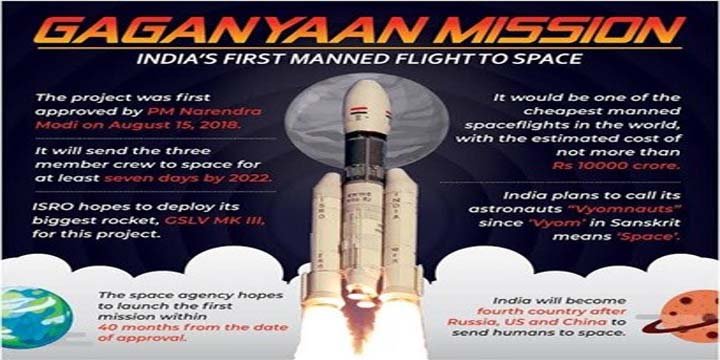Gaganyaan Mission
Context:
- On Saturday, less than two months after the Chandrayaan-3 Moon landing, ISRO will carry out the first of a series of tests of systems and procedures with the aim to ultimately launch an Indian astronaut into space, perhaps in 2025.
- The Flight Test Vehicle Abort Mission-1 (TV-D1) will demonstrate the performance of the Crew Escape System of the Gaganyaan project.
- The flight will be the first of two abort missions to test the safety mechanisms that will allow the Gaganyaan crew to leave the spacecraft in an emergency.
- The test exercise will see the rocket rise to an altitude of almost 17 km before an abort signal is triggered, leading to the separation of the crew module, which will descend using a parachute for a splashdown in the Bay of Bengal.
What will be tested?
- Saturday’s TV-D1 flight will demonstrate, first, the new Test Vehicle — this is the reason why the test has been named Test Vehicle-Demonstration 1 (TV-D1).
- Second, it will demonstrate a basic version of the crew module — the capsule in which the astronauts will be seated during the Gaganyaan human space flight.
About Gaganyaan:
- Gaganyaan project envisages demonstration of human spaceflight capability by launching crew of 3 members to an orbit of 400 km for a 3 days mission and bring them back safely to earth, by landing in Indian sea waters.
Human rated LVM3 – HLVM3:
- LVM3 rocket – The well proven and reliable heavy lift launcher of ISRO, is identified as the launch vehicle for Gaganyaan mission.
- It consists of solid stage, liquid stage and cryogenic stage. All systems in LVM3 launch vehicle are re-configured to meet human rating requirements and christened Human Rated LVM3.
- HLVM3 will be capable of launching the Orbital Module to an intended Low Earth Orbit of 400 km.
- HLVM3 consists of Crew Escape System (CES) powered by a set of quick acting, high burn rate solid motors which ensures that Crew Module along with crew is taken to a safe distance in case of any emergency either at launch pad or during ascent phase.
Orbital Module:
- Orbital Module (OM) that will be Orbiting Earth comprises of Crew Module (CM) and Service Module (SM).
- OM is equipped with state-of-the-art avionics systems with adequate redundancy considering human safety.
- CM is the habitable space with Earth like environment in space for the crew.
- It is of double walled construction consisting of pressurized metallic Inner Structure and unpressurised External Structure with Thermal Protection System (TPS).
- It houses the crew interfaces, human centric products, life support system, avionics and deceleration systems.
- It is also designed for re-entry to ensure safety of the crew during descent till touchdown.
- SM will be used for providing necessary support to CM while in orbit.
- It is an unpressurized structure containing thermal system, propulsion system, power systems, avionics systems and deployment mechanisms.
Crew training for Gaganyaan:
- Astronaut Training Facility established in Bengaluru caters to Classroom training, Physical Fitness training, Simulator training and Flight suit training.
- Training modules cover academic courses, Gaganyaan Flight Systems, Micro-gravity familiarization through Parabolic Flights, Aero-medical training, Recovery & Survival training, mastering of Flight Procedures and training on Crew Training Simulators.
- Aero medical training, Periodical flying practice and Yoga are also included as part of the training.
CHALLENGES:
- Gravity Field:
- Transitioning from one gravity field to another is tricky.
- It affects hand-eye and head-eye coordination.
- Nasa has learned that without gravity working on the human body, bones lose minerals.
- Even after one return from a space mission, he/she could be at greater risk of osteoporosis-related fractures.
- Isolation:
- Due to isolation, one may encounter depression, fatigue, sleep disorder and psychiatric disorders.
- Radiation:
- In space stations, astronauts receive over ten times the radiation than what people are subjected to on Earth.
- Radiation exposure may increase the risk of cancer. It can damage the central nervous system.
- Radiation can also cause nausea, vomiting, anorexia, and fatigue.
- Rockets:
- Rockets are extreme machines.
- Travelling in a rocket is like sitting on an exploding bomb which will push your speed from 0 kmph to 29,000 kmph in less than 30 minutes.
- Many things can go wrong during the launch phase, including the rocket exploding into a fireball.
- Many safety features have to be built into rocket systems to ensure the probability of loss of life is minimized.
- However, testing of all these systems in an actual operating environment is next to impossible and a calculated risk has to be taken while embarking on such a mission.
- Hostile environment:
- Space is hostile. In addition to lack of gravity and danger of radiation, there is no atmosphere.
- Human blood starts boiling if there is no pressure.
- The ‘Gaganyaan’ has to create an atmosphere like Earth inside a small volume and ensure that adequate supply of oxygen, removal of carbon-dioxide and comfortable temperature and humidity levels are maintained throughout the mission.
Way forward:
- After the successful completion of the Gaganyaan program, the immediate step will focus on achieving the capability for a sustained human presence in space.
- By successfully implementing the program India would establish itself as the leading country in space sector.
Syllabus: GS III – Science and Technology
SOURCE: THE INDIAN EXPRESS




